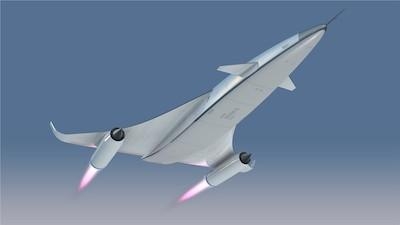Marks Milestone In Development Of SABRE Engine
U.K. company Reaction Engines has tested its innovative precooler at airflow temperature conditions equivalent to Mach 5, or five times the speed of sound. This achievement marks a significant milestone in its ESA-supported development of the air-breathing SABRE engine, paving the way for a revolution in space access and hypersonic flight.

The precooler heat exchanger is an essential SABRE element that cools the hot airstream generated by air entering the engine intake at hypersonic speed.
“This is not only an excellent achievement in its own right but one important step closer to demonstrating the feasibility of the entire SABRE engine concept,” said Mark Ford, heading ESA’s Propulsion Engineering section.
The Synergetic Air-Breathing Rocket Engine (SABRE) is uniquely designed to scoop up atmospheric air during the initial part of its ascent to space at up to five times the speed of sound. At about 65,000 feet, it would then switch to pure rocket mode for its final climb to orbit.
In future SABRE could serve as the basis of a reusable launch vehicle that operates like an aircraft. Because the initial flight to Mach 5 uses the atmospheric air as one propellant it would carry much less heavy liquid oxygen on board. Such a system could deliver the same payload to orbit with a vehicle half the mass of current launchers, potentially offering a large reduction in cost and a higher launch rate.
Reaction Engines constructed the precooler test item in the U.K., then shipped it to its specially constructed facility at the Colorado Air and Space Port in the U.S. for its test campaign.
This ground-based test achieved the highest temperature objective of the company’s ‘HTX’ hot heat exchanger test programme: it successfully quenched airflow temperatures in excess of 1000°C in less than 1/20th of a second.
The tests demonstrated the precooler’s ability to cool airflow at speeds significantly in excess of the operational limit of any jet-engine powered aircraft in history. Mach 5 is more than twice as fast as the cruising speed of Concorde and over 50% faster than the SR-71 Blackbird aircraft – the world’s fastest jet-engine powered aircraft.
This most recent test builds upon the success of previous HTX hot tests undertaken in April which saw the precooler successfully operate at temperatures of 420°C – matching the thermal conditions corresponding to Mach 3.3 flight.
ESA, via the U.K. Space Agency, has invested $11 million in SABRE development, together with $64.5 million from U.K. SA. ESA also performs a technical oversight role on behalf of U.K.SA. In March, the two agencies reviewed and validated the preliminary design of the demonstrator engine core of SABRE, which Reaction Engines will use to undertake ground-based testing at its under-construction TF1 test facility at Westcott, Buckinghamshire, U.K.
Reaction Engines co-founder and current Chief Technology Officer Richard Varvill emphasised that this achievement was the culmination of more than 30 years of effort: “This is a momentous landmark for Reaction Engines in the development of its SABRE engine, which has the potential to revolutionize both access to space and high-speed flight by powering aircraft to five times the speed of sound.
(Image provided with European Space Agency news release)
 Classic Aero-TV: Remembering Bob Hoover
Classic Aero-TV: Remembering Bob Hoover ANN FAQ: Follow Us On Instagram!
ANN FAQ: Follow Us On Instagram! ANN's Daily Aero-Linx (05.15.24)
ANN's Daily Aero-Linx (05.15.24) ANN's Daily Aero-Term (05.15.24):Altimeter Setting
ANN's Daily Aero-Term (05.15.24):Altimeter Setting Aero-News: Quote of the Day (05.16.24)
Aero-News: Quote of the Day (05.16.24)



